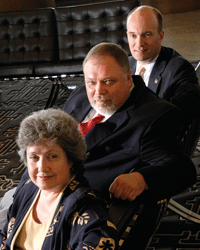When Renaissance-era merchants developed modern banking networks in the 1500s, many of their customers believed that the banks simply kept all the gold in a secure vault. The Medici family and other bankers didn't highlight the fact that they loaned out most of the gold to other merchants, to the nobility and to monarchs.Just like today, those early bankers kept enough gold'cash'on hand to meet the withdrawals they expected. But when confidence in their ability to pay wavered, the Medicis couldn't immediately call in their long-term loans, and their banks failed.Banking today has improved'but, like the value of the currency itself, it relies largely on the trust of the public.Banks not only have a 'lender of last resort,' in the form of the Federal Reserve System, to back them up, but depositors benefit from insurance provided via the Federal Deposit Insurance Corp.The Office of the Comptroller of the Currency is another regulatory agency that, like the Fed and FDIC, ensures banks' financial health through regular oversight.The three agencies work together through the Federal Financial Institutions Examination Council to harmonize their oversight methods.Late last year, the federal bank regulatory agencies launched the first large-scale instance in the country, and the largest worldwide, of a cross-industry standard for representing and reporting financial data.The agencies are using extensible business reporting language, or XBRL, to speed access to information about banks' financial health and help eliminate errors in data.The oversight agencies collect financial data on some 8,000 banks across the country. Some very large banks with balance sheets running to a trillion dollars have permanent cadres of bank regulators on site.Smaller banks, with deposits in the $10 million to $20 million range, submit simpler reports to the regulators.The data is intended to ensure that banks maintain adequate capital and that they control their ratios of nonperforming loans.All this regulatory oversight is aimed at maintaining confidence in the banking system while assuring compliance with consumer protection and bank integrity requirements.Martin D. Henning, associate director of FDIC's Statistics Branch in the Division of Insurance and Research, worked as project director on the Call Report Modernization Project.'One of the key things about this project is that we are using an application service provider [Unisys Corp.] to furnish a Web-based system,' Henning said.[IMGCAP(2)]Mary M. West, assistant director of the Federal Reserve System's Division of Research and Statistics, said, 'We made changes in the business rules [of each of the three agencies] to make it easier [for the system] to edit the data. XBRL has made it much easier to edit the data.'As far as the technology involved in the project, 'We pushed the envelope,' West said.In addition to defining and implementing the technology, the three agencies had to harmonize their requirements for the system, which called for heavy lifting.'Some of the requirements meetings went on for eight hours a day for several days,' she said.The three agencies prepared their project plan for two years and decided to use XBRL in 2003. After releasing a proposal request and receiving nine responses, they awarded Unisys a $39 million, 10-year contract.The agencies launched the Central Data Repository on Oct. 1, 2005, in a 'big bang' switch from two legacy mainframe systems. Before the switch to the new system, the agencies checked out the CDR in three separate and progressively expanded tests.The three agencies required the banks to submit their third quarter 2005 Call Report data to the new CDR using XBRL as the reporting language.'In the past, it took up to 25 days before the banks' data were really ready for use,' West said. 'Now, we can start using some of the data within days.'The XBRL tags and associated apps help banks and their vendors who submit data to the CDR flag errors in their submissions, just as a tax preparation programs such as TurboTax flag errors that taxpayers might miss. As a result, up to 95 percent of the data now received meets CDR requirements, in contrast to the previous rate of 66 percent clean submissions.The system's ability to suppress errors via internal self-checking, or editing, is one of the ways that it benefits the banks as well as the regulators, according to Robin Stefan, national bank examiner with the Office of the Comptroller of the Currency.'These edits had to be merged [among the three agencies],' Stefan said.In addition, the agencies were concerned about the regulatory burden the reporting requirements imposed, Stefan said.'There were initial startup costs,' West said, 'but now we are through the transition, [and] it is less burdensome.'Rosemary George, special assistant to the FFIEC, said, 'The transition had to be a big bang because we couldn't ask the banks to report twice for that quarter. So we had backup plans [in case of problems].'In addition to using XBRL tags to help validate the bank data, the CDR uses other Extensible Markup Language specifications, such as XML Schema and Xlink, that work together to check relationships among data elements and verify the data's semantics.The agencies work together each quarter to tweak the taxonomy of terms and definitions that frame the CDR data elements.Every year, they issue a major revision of the taxonomy that reflects new accounting rules and financial procedures.The final result of the CDR is not only better service to the bank examiners, banks and members of the public who use the information, but lower costs of regulation.In the past, Henning said, bank regulators would have to chase down errors in the call reports via phone calls, e-mails or faxes.'Now, if you have [a bank executive] on the phone, you can have them submit the information, and you can see it on your screen immediately,' he said.Henning added, 'There is a quarterly banking profile [publication] that is now coming out about three weeks earlier [than before the CDR started].'
INSTANT RESULTS: The CDR allows regulators to see call report corrections on screen immediately, says FDIC's Martin D. Henning.
Zaid Hamid
IN THREES: The three FFIEC agencies conducted three progressively expanded tests of the CDR before its 'big bang' launch, say (from front) Mary West, Robin Stefan and Martin Henning.
Zaid Hamid








